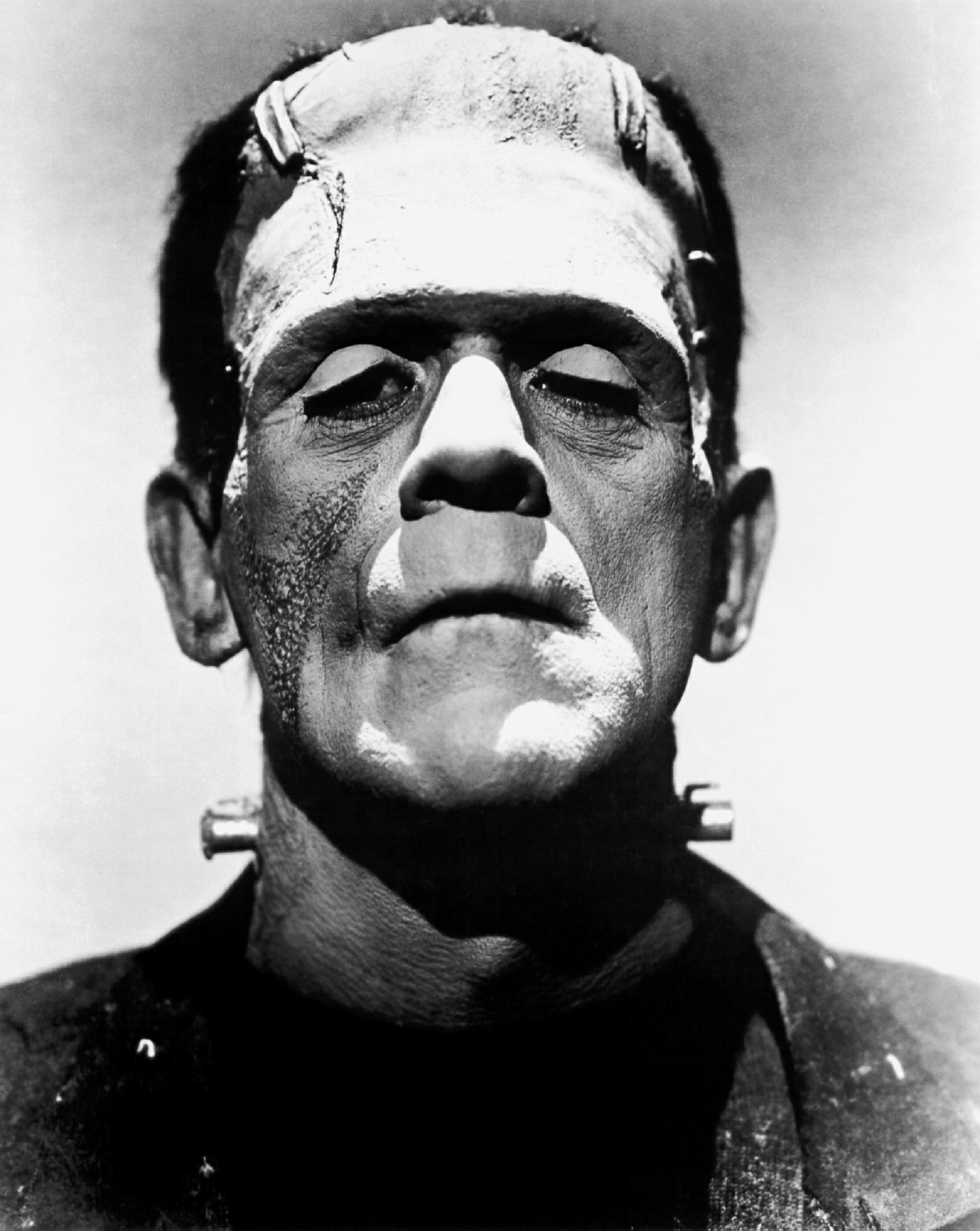 Submitted by Unself on
Submitted by Unself on

‘It was the secrets of heaven and earth that I desired to learn; and whether it was the outward substance of things or the inner spirit of nature and the mysterious soul of man that occupied me, still my inquiries were directed to the metaphysical ...’
Mary Shelley – Frankenstein
THE night sky is dismal, disconsolate, a graveyard of colourless clouds. Then, it is shot through with an electric, lightning flash. There is a rumble of thunder as the heavens burst open, which pour with unappeasable rain. Far beneath, heedless of all this savage nature, a man labours at his creation. In an upper chamber, the man – a scientist – sends a high-voltage current through the half-awake Goliath on the laboratory table. And are those metal terminals embedded in its neck? At this new shock the creature begins to stir. Discarding his shackles he gets to his feet and shambles, his arms stretched out before him like a phantom menacing the house…
You get the picture – this cinematic caricature of Frankenstein’s monster coming to life. The basic literary story is as follows: an over-ambitious science student from Geneva, Victor Frankenstein, on a quest to discover what truly drives human life, re-animates a composite human creature from the recently dead. Thus his troubles begin, and the narrative turns as we come to know the interior life of the creature (who wonders why he has been created) and of Victor’s anguish at having tampered with Mother Nature in such brazen a manner. Victor ends up pursuing the unnamed being into the frozen wastes of the Arctic, though is eventually killed by his creation, who – after murdering his master – vows to immolate himself on a funeral Pyre.
But, unknown to many readers, Mary Shelley’s original novel of 1818 is laced with magical symbolism, specifically that of alchemy – for it depicts the process of the Hermetic ‘death’ of the everyday conscious mind (with its imperfect hold on reality, its doubts, fears and ignorance). That is, its overall lowliness in the grand scheme of things. (In that it’s inferior to the Unconscious and spiritual energies, generally.) The ‘death’ occurs so that spiritual perfection can finally be achieved – the so called Alchemical Wedding, the perfect union of Male and Female energies.
All of this may sound preposterous to a fan of Mary Shelley, but the clues – whilst deeply buried – remain. We can see that whoever wrote the book has, at some time or other, been exposed to the secret teachings of Alchemy. On the surface, there are plenty of references to the sages and alchemists of old – at one point Victor Frankenstein is upbraided for his interest in Albertus Magnus, Paracelsus and Heinrich Cornelius Agrippa whom he enthusiastically calls ‘the masters of science’. But there are deeper influences, one being Mary’s Shelley’s husband, the Romantic poet Percy Bysse Shelley. It is well known that Percy not only made additions to Mary’s book, but provided the underlying philosophy for it: via his epic poem Prometheus Unbound, about the doomed Greek god chained to a rock in eternal punishment for stealing fire from heaven (‘enlightenment’) and gifting it to the human race.
For Percy Shelley, Prometheus (whose name means ‘foresight’) was a noble and heroic figure – hence the subtitle of his wife’s novel, ‘The Modern Prometheus’. So let’s look at the symbolism in this Gothic, fictional classic. Firstly, the name Frankenstein. It is a matter of record that Mary and her husband once visited Castle Frankenstein near Darmstadt, en route to Switzerland, where a well known alchemist had experimented with human bodies. Here is the main catalyst, but when we analyse the name, subtle clues are revealed. The first part, ‘Frank’, derives from the Old French ‘franc’ meaning ‘free’, synonymous with ‘outspoken’, ‘sincere’, ‘genuine’, or – if you prefer – truthful. ‘Stein’ is the German for Stone, and thus we arrive at True Stone, an allusion to the Alchemical goal – the Philosopher’s Stone. As for the name ‘Victor’, when we consider that Milton (in his Paradise Lost) often calls God “the Victor”, we can deduce that Victor Frankenstein’s Christian name signifies he’s playing God by trying to create life. Percy’s epic poem was inspired by the poet Ovid’s Prometheus Bound from Classical Rome. He asks if Humankind hadn’t been created by Prometheus himself:
Did the Unknown God designing then a better world make man of seed divine?
Or did Prometheus take the new soil of earth (that still contained some godly element of Heaven’s Life) and use it to create the race of man?
On earth the brute creation bends its gaze, but man was given a lofty countenance and was commanded to behold the skies.1
And so Frankenstein, the Modern Prometheus, is a metaphor for the power to create life. Then, as rain beat down outside, Victor ‘saw the dull yellow eye of the creature open; it breathed hard, and a convulsive motion agitated its limbs.’ Commentators have found this section puzzling: there is no description of any gadgetry or apparatus that would stimulate the creature to life (as with the Hollywood film versions). But this was deliberate, for this ‘creation’ is not made of flesh, but is the unregenerate, lower-mind personified. The ‘creature’ is really Victor’s alter-ego come to life, a creation of the mind, rather like the character of Tyler Durden in Fight Club, he is the repressed Jungian Shadow – our Mr Hyde aspect. This can be gleaned from the author’s original introduction, when Mary recalls how she, her husband and Lord Byron decided that each of them would write a supernatural tale. One night she had gone to bed, when in her mind’s eye she imagined
‘the hideous phantasm of a man stretched out, and then, on the working of some powerful engine, show signs of life, and stir with an uneasy, half vital motion. Frightful must it be; for supremely frightful would be the effect of any human endeavour to mock the stupendous mechanism of the Creator of the world.’
The word ‘engine’, here, has a secret allegorical meaning for those in the know. Derived from the old French word ‘engin’ – meaning ‘skill’ or ‘cleverness’ it is derived from the Latin ‘ingenium’ (hence our word ‘ingenious’), referring to innate, inborn qualities. Qualities of the mind. The ‘powerful engine’ Mary mentions is the enormous power of thought itself (more of which, later.)
Thereafter follows a long series of adventures where the creature causes three deaths by strangulation, (i.e. at the throat), alluding to the separation of the head from the body. (Threefold Deaths also occur in Celtic myth and Freemasonic legend.) Plus, three is a symbolic number in Alchemy – there are three main stages of spiritual development, represented by three colours: Black (ignorance), White (approaching purity) and Red (perfection). Thus we learn that Victor has also toiled for ‘nearly two years, for the sole purpose of infusing life into an inanimate body.’ The two years refers to the second stage in Alchemy– approaching perfection. However, the ‘creature’ is that part of the conscious mind which must ‘die’ if the alchemical transformation is to succeed and the True Stone (the ‘Frankenstein’) realised.
In one revealing encounter the creature announces to Victor: “It is well. I go; but remember, I shall be with you on your wedding-night.” This is repeated five times in the narrative and may appear to be a straightforward statement, but it’s an allusion to the ‘Alchemical Marriage’ – that hoped for state of spiritual regeneration. The anonymous seventeenth century fable, The Chymical Wedding Of Christian Rosenkreutz, is an Hermetic allegory in which the title character receives a mysterious invitation:
This day, today
Is the Royal Wedding day.
For this thou wast born
And chosen of God for joy
But the ‘wedding’ is a symbolic one – that of the reconciliation of opposites (spiritual/material; divine/human; masculine/feminine). These are all processes occurring within the alchemist at some deep, unconscious level. The death and rebirth in The Chymical Wedding occurs when a sinister black Arab (the Moor) beheads six royal guests, whereupon he himself is then decapitated. Decapitation symbolises the ‘removal’ of the imperfect conscious ego (head) from its spiritual source, the Unconscious. Only then can the long process of transformation begin. As Manly P Hall has written, ‘in the Hermetic Marriage divine and human consciousness are united in holy wedlock.’ And so, beneath the narrative of Frankenstein, Divine Consciousness (Victor) and inferior human consciousness (the monster) are there to be united in the Alchemical Wedding which must be preceded by Alchemical Death. This occurs at the end of Mary Shelley’s story, in the snowy tundra of the Arctic circle – a fittingly remote and barren wasteland.
But the deeper and more sublime teachings that underlie Mary’s narrative belong to Percy’s metaphysical view on life, one laden with profound occult thinking: As one commentator put it: ‘The Romantic idealism of Shelley and his overreaching heroes was … based on a faith in man’s ‘divine’ or creative powers’2 Just as – traditionally – God created Man in his His own image, so does man have the power to create via Thought (a very familiar idea to modern magicians). In fact, for Percy Shelley, we are also gods! We ‘create’ and ‘animate’ the world through Consciousness – the philosophy of idealism says that there isn’t really a world ‘out there’ without Consciousness to perceive it. Here are Percy Shelley’s own words on the nature of thought:
‘It is probable that what we call thought is not an actual being, but no more than the relation between certain parts of that infinitely varied mass, of which the rest of the universe is composed, . .. But let thought be considered as some peculiar substance, which permeates, and is the cause of, the animation of living beings.’ 3
This is the World as Idea, like Plato’s World Soul, the ‘ether’ of pseudoscience, the filaments of a Universal Intelligence which connect all of Reality, both animate and inanimate Nature. (What Aldous Huxley once called ‘Mind at Large’.) Just as when Isaac Newton declared that ‘we cannot say that all nature is not alive’, Shelley is saying that ‘thought power’ permeates through and lies at the centre of the Universe: remember how Mary also wrote about that ‘powerful engine’, the power of thought – the Cosmic Mind. The modern equivalent would be when the astronomer Eddington wrote that ‘the stuff of the world is Mind-Stuff’, or when his French counterpart, Camille Flammarion, said that, in the Universe at large, Mind gleams through its every atom. These are wide-ranging magical teachings, belonging to philosophies like Vitalism, Pan-Psychism, Animism, and of course, Hermeticism – the domain of the Alchemist. Yes, dear reader, there is more than meets the eye in Frankenstein! Perhaps this is why we find this intriguing preface in Mary’s text hinting – as with all Hermetic books – that something of greater import is being concealed:
‘I see by your eagerness and the wonder and hope which your eyes express, my friend, that you expect to be informed of the secret with which I am acquainted; that cannot be; listen patiently until the end of my story, and you will easily perceive why I am reserved upon that subject".4
James Lynn Page
http://www.astro.nu/2018/10/17/secret-frankenstein-mary-shelley/
1. From Ovid, Metamorphoses (Book I; Fable Ii)
2. Maurice Hindle from the introduction to the Penguin Classics edition of Frankenstein, 1985.
3. Shelley, On A Future State – A Defence Of Poetry And Other Essays (italics added).
4. Mary Shelley (Frankenstein, or The Modern Prometheus)
The above is an edited version of The Hermetic Frankenstein Unveiled: What Mary Shelley Knew about Alchemy which appeared in Vol. XXXI (no. 3) of Diamond Fire magazine.
- 604 reads